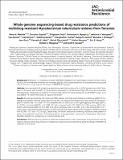| dc.description.abstract | Background: Rifampicin- or multidrug-resistant (RR/MDR) Mycobacterium tuberculosis complex (MTBC) strains
account for considerable morbidity and mortality globally. WGS-based prediction of drug resistance may guide
clinical decisions, especially for the design of RR/MDR-TB therapies.
Methods: We compared WGS-based drug resistance-predictive mutations for 42 MTBC isolates from MDR-TB pa tients in Tanzania with the MICs of 14 antibiotics measured in the Sensititre™ MycoTB assay. An isolate was
phenotypically categorized as resistant if it had an MIC above the epidemiological-cut-off (ECOFF) value, or as
susceptible if it had an MIC below or equal to the ECOFF.
Results: Overall, genotypically non-wild-type MTBC isolates with high-level resistance mutations (gNWT-R) cor related with isolates with MIC values above the ECOFF. For instance, the median MIC value (mg/L) for rifampicin gNWT-R strains was .4.0 (IQR 4.0–4.0) compared with 0.5 (IQR 0.38–0.50) in genotypically wild-type (gWT-S,
P,0.001); isoniazid-gNWT-R .4.0 (IQR 2.0–4.0) compared with 0.25 (IQR 0.12–1.00) among gWT-S (P=
0.001); ethionamide-gNWT-R 15.0 (IQR 10.0–20.0) compared with 2.50 (IQR; 2.50–5.00) among gWT-S (P,
0.001). WGS correctly predicted resistance in 95% (36/38) and 100% (38/38) of the rifampicin-resistant isolates
with ECOFFs .0.5 and .0.125 mg/L, respectively. No known resistance-conferring mutations were present in
genes associated with resistance to fluoroquinolones, aminoglycosides, capreomycin, bedaquiline, delamanid,
linezolid, clofazimine, cycloserine, or p-amino salicylic acid.
Conclusions: WGS-based drug resistance prediction worked well to rule-in phenotypic drug resistance and the
absence of second-line drug resistance-mediating mutations has the potential to guide the design of RR/MDR-TB
regimens in the future. | en_US |

